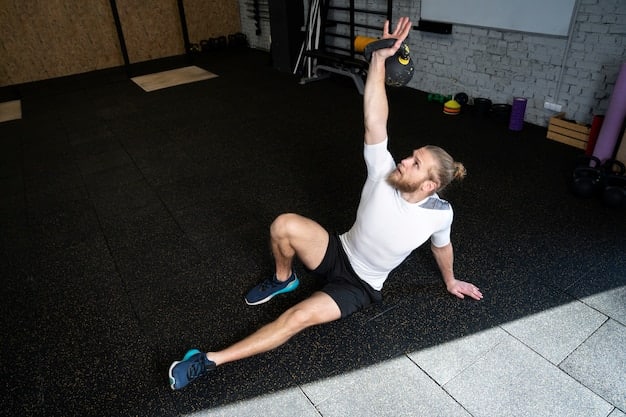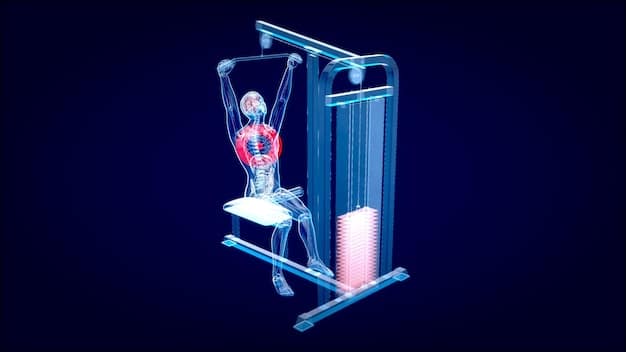Break Through Plateaus: Advanced Isometric Workouts for Strength Gains

An advanced isometric workout routine leverages static holds to build strength, overcome training plateaus, and enhance muscle endurance by maximizing time under tension without joint movement.
For many fitness enthusiasts, reaching a training plateau can be a frustrating and demotivating experience. It’s that moment when your progress stalls, and despite your best efforts, you just can’t seem to get stronger or break new personal records. This challenging phase is where an advanced isometric workout routine for strength gains can become a game-changer. Isometrics, involving muscle contractions without visible movement, offer a unique pathway to bypass these plateaus and unlock new levels of strength.
Understanding Isometrics: Beyond Static Holds
Isometrics, at their core, involve muscle contraction against an immovable object or resistance, where the muscle length does not change and no joint movement occurs. While often perceived as simply “holding a position,” the true depth of isometric training extends far beyond this basic definition. It’s about maximizing tension and recruiting high-threshold motor units that might be underserved by traditional dynamic movements. Consider the subtle yet profound difference between holding a heavy weight steady and actively pushing or pulling against an unyielding force; the latter often elicits a far greater physiological response.
The science behind isometric training is rooted in its ability to generate immense force. When a muscle contracts isometrically, all its fibers are engaged simultaneously to maintain the position, leading to significant strength adaptations. Moreover, this type of training can be performed at specific joint angles, allowing athletes to target and strengthen weak points in their range of motion, which are often the very areas responsible for plateaus in dynamic lifts. This precision makes isometrics an invaluable tool for both general strength development and specialized athletic performance.
The Physiology of Static Contractions
Delving deeper into the physiology, isometric contractions can recruit a greater proportion of muscle fibers compared to dynamic movements, especially at maximal effort. This heightened recruitment is critical for building brute strength. Furthermore, the prolonged tension inherent in isometric holds enhances blood flow restriction and metabolic stress, leading to cellular adaptations that contribute to both strength and endurance. It’s a dense, potent stimulus that can elevate a lifter’s capacity.
- Increased Muscle Fiber Recruitment: Isometrics engage more muscle fibers, including fast-twitch fibers, than dynamic movements at similar intensities.
- Enhanced Neuromuscular Efficiency: Improves the brain’s ability to communicate with muscles, leading to more powerful contractions.
- Specific Angle Strength Gains: Builds strength at precise joint angles, addressing sticking points in lifts.
- Reduced Joint Stress: As there’s no movement, isometrics are easier on joints compared to dynamic exercises.
Isometrics also play a vital role in rehabilitation and injury prevention. By strengthening muscles without stressing joints through movement, they are ideal for individuals recovering from injuries or those looking to fortify vulnerable areas. The controlled nature of the exercise minimizes the risk of further damage, and the targeted strength gains can help stabilize joints and improve overall structural integrity. This dual benefit of strength building and safety makes isometrics a versatile and essential component of a well-rounded training regimen.
Breaking Down Plateau Barriers with Isometrics
Plateaus are a common, yet often frustrating, aspect of any strength training journey. They occur when the body adapts to the current training stimulus, and the same old routines no longer yield the desired results. This adaptation can stem from various factors, including neurological efficiency reaching its peak, muscle fiber recruitment stalling, or simply a lack of novel stimuli. Isometrics offer a unique and powerful approach to circumvent these barriers, providing a fresh challenge that forces the body to adapt in new ways.
One of the primary ways isometrics dismantle plateaus is by enhancing strength at specific sticking points. Many lifters find themselves failing at a particular point in a movement – be it the bottom of a squat, the midpoint of a bench press, or the lockout of a deadlift. Isometric holds performed at these exact angles can dramatically improve the force output capability in that specific range, effectively “greasing the groove” and allowing the lifter to power through previously insurmountable obstacles. It’s a concept validated by numerous athletes and coaches who incorporate it into their routines.

Targeted Strength Development at Key Angles
The beauty of isometric training lies in its precision. Unlike dynamic movements that distribute tension across a full range of motion, isometrics concentrate tension at a specific joint angle. This focused intensity allows for a rapid increase in strength at that isolated point. For example, if your squat stalls half-way up, performing isometric holds at that exact depth can significantly bolster the strength required to push past it. This acute targeting creates localized strength gains that translate directly to improved performance in your primary lifts.
- Overcoming Sticking Points: Directly strengthens the weakest part of a lift, enabling lifters to push through plateaus.
- Enhanced Neurological Drive: Improves the brain’s ability to activate and recruit muscle fibers at specific angles.
- Increased Time Under Tension: Prolonged static holds maximize muscle engagement, leading to greater strength adaptations.
- Improved Force Production: Develops the capacity to generate maximal force at critical points in a movement.
Furthermore, isometrics can improve neural drive, which is the efficiency with which your nervous system activates your muscles. When you push against an immovable object with maximal effort, your brain learns to recruit more muscle fibers and activate them more synchronously. This improved neural communication translates to greater overall strength and power, even in dynamic movements. By integrating isometric holds into a routine, you’re not just making your muscles stronger; you’re making your nervous system smarter and more effective at driving those muscles.
Designing Your Advanced Isometric Routine
Crafting an advanced isometric workout routine requires a strategic approach, moving beyond simple static holds to incorporate principles that maximize strength gains. The key is to vary the intensity, duration, and specific type of isometric contraction to continually challenge the body. A well-designed routine will integrate different forms of isometrics, such as yield, overcoming, and eccentric isometrics, each offering distinct benefits for strength development and plateau breaking.
When structuring your routine, consider including a mix of exercises that target major muscle groups commonly involved in your primary lifts. For instance, if your goal is to improve your bench press, incorporate isometric holds at various angles – the bottom, midpoint, and lockout – using a power rack or a partner providing resistance. Similarly, for squats and deadlifts, focus on holds at depths where you typically fail. The aim is to create a comprehensive stimulus that addresses all aspects of your strength profile, enhancing both absolute strength and stability.
Key Principles for Maximizing Isometric Gains
To truly advance with isometrics, focus on specific parameters. Time under maximal tension during a hold is crucial; short, intense bursts are different from longer, sustained holds. Incorporating different types of isometric contractions – like yield isometrics (holding a heavy weight stationary) versus overcoming isometrics (pushing against an immovable object) – ensures a diverse stimulus that challenges muscles in varied ways.
- Maximal Intent: Every isometric hold should be executed with the intent to generate maximal force, even if no movement occurs.
- Specific Joint Angles: Focus on strengthening specific angles relevant to your sticking points in dynamic lifts.
- Varying Intensity and Duration: Experiment with short, maximal holds (5-10 seconds) for strength, and longer, sub-maximal holds (20-30 seconds) for endurance.
- Progressive Overload: Gradually increase the intensity or duration of your holds, or decrease rest times, to continue challenging your muscles.
Integrating isometric holds into your existing strength routine can be done in several ways. You can use them as a finisher after your main lifts to accumulate more time under tension and exhaust muscle fibers. Alternatively, they can be employed as a pre-fatigue method, activating specific muscle groups before performing dynamic exercises. For those looking to explicitly target sticking points, dedicating specific warm-up sets or even standalone sessions to isometric holds at those angles can yield significant improvements. The flexibility of isometrics allows for seamless integration into almost any training program.
Advanced Isometric Exercises for Each Major Lift
To effectively break through strength plateaus, an advanced isometric routine must target the specific mechanics of major compound lifts. This means moving beyond generic wall sits and plank holds to exercises that mimic the force vectors and muscle engagement patterns of the squat, bench press, and deadlift. By applying isometric principles directly to these foundational movements, athletes can develop targeted strength and overcome persistent sticking points.
For the squat, consider variations like the pin squat hold or the rack isometric squat. These exercises involve setting pins in a power rack at your sticking point, then squatting down to that depth and pushing maximally against the pins for a specific duration. This method builds immense strength at your weaker joint angles, translating directly to a more powerful ascent in your dynamic squat. Similarly, for the bench press, the pin press hold or floor press isometric can fortify the mid-range and lockout, which are common failure points.
Specific Isometric Drills for Compound Movements
Implementing targeted isometric exercises for compound movements is crucial for real-world strength transference. These drills isolate the most challenging parts of big lifts, allowing for focused strength gains.
- Squat Isometrics:
- Pin Squat Holds: Set pins in a power rack at your sticking point. Descend to the pins, push forcefully against the bar (which is resting on the pins) for 5-10 seconds without moving. This builds strength at precise vulnerable depths.
- Rack Isometric Squat: Position the barbell on pins just a few inches above your weakest point. Get under the bar and push upwards against it with maximum effort, as if trying to lift an immovable object.
- Bench Press Isometrics:
- Pin Press Holds: Similar to pin squats, set pins in a power rack a few inches above your chest, at your sticking point. Press the barbell up into the pins with maximal force for 5-10 seconds.
- Floor Press Isometric: Lie on the floor, set the bar on a high rack, and press vigorously upwards into an immovable bar from a specific angle, ensuring full muscle contraction.
- Deadlift Isometrics:
- Rack Pull Isometrics: Set the barbell on pins in a power rack at various heights – just below the knee, mid-thigh, or at lockout. Pull upwards with maximal force for 5-10 seconds. This targets different ranges of motion in the deadlift.
- Overcoming Deadlift Isometrics: Secure the bar to the rack or floor with chains/straps so it cannot move. Assume your deadlift starting position and pull with maximum intent for 5-10 seconds.
For the deadlift, which is often limited by grip strength or the ability to break the weight off the floor, rack pull isometrics or overcoming deadlift isometrics are highly effective. Setting the pins at different heights allows you to strengthen specific segments of the pull, from the initial break to the lockout. Overcoming isometrics, where you pull against an absolutely immovable bar, recruit maximum motor units and teach your body to generate incredible force from a static position. Integrating these targeted isometric exercises strategically into your program will directly address and rectify weaknesses in your major lifts.
Integrating Isometrics into Your Training Cycle
Successfully incorporating an advanced isometric workout routine requires careful planning within your broader training cycle. It’s not about substituting all dynamic movements with static holds, but rather intelligently weaving isometrics into your existing program to complement and enhance your strength progression. The timing and frequency of isometric training can significantly impact its effectiveness, preventing overtraining while maximizing its benefits.
One common strategy is to use isometrics during a strength block, where the primary goal is to increase maximal force production. During these periods, isometrics can be performed either before your main competitive lifts (to pre-activate specific muscles and pathways), or after (as a finisher to accumulate more muscle tension and volume at specific angles). Another effective approach is to dedicate specific microcycles or weeks to isometric training, especially when approaching a deload or a peaking phase, to consolidate strength gains without excessive fatigue to the central nervous system. This strategic placement helps in managing recovery and avoiding burnout.
Periodization and Recovery Considerations
Periodization is key to integrating isometrics effectively. They can be used as a primary training method for a short block (e.g., 2-4 weeks) or as a supplementary tool within longer training cycles. The high neurological demand of maximal isometrics necessitates adequate recovery to prevent central nervous system fatigue.
- Strength Blocks: Integrate short (5-10 sec) maximal intensity isometrics before or after main lifts 1-2 times per week.
- Deload Weeks: Utilize sub-maximal isometrics (15-30 sec) to maintain tension and neural connections without heavy joint stress.
- Active Recovery: Longer, lower-intensity isometric holds can improve blood flow and aid recovery on off-days.
- Listen to Your Body: Monitor fatigue levels closely, as maximal isometrics can be very demanding on the nervous system. Ensure sufficient rest and nutrition.
Recovery is paramount when incorporating high-intensity isometric contractions. While isometrics are often lauded for their low joint impact, they are incredibly demanding on the central nervous system. Therefore, ensure you are getting adequate sleep, maintaining proper nutrition, and not overdoing the frequency or intensity of your isometric sessions. For example, limit maximal isometric holds to 1-2 times per week for a given muscle group, allowing sufficient time for neural recovery. By balancing intense isometric work with proper recovery, you can unlock unparalleled strength gains while maintaining long-term training sustainability and avoiding injury.
Measuring Progress and Adjusting Your Isometric Strategy
Successfully integrating an advanced isometric workout routine is only half the battle; the other half involves meticulously measuring your progress and making informed adjustments to your strategy. Unlike dynamic movements where progress is often quantified by increased weight or repetitions, measuring gains in isometric strength requires a different approach. This often involves specific testing protocols and careful observation of how isometric improvements translate to your dynamic lifts.
One effective method for tracking isometric progress is through the use of a force plate or a simple bathroom scale placed under the immovable object you’re pushing against. While expensive force plates offer precise measurements, even a scale can provide qualitative feedback on your ability to generate more force over time. Alternatively, you can use a timing device to consistently measure the duration you can hold a maximal contraction against an immovable object, striving to increase that time while maintaining peak intensity. This data provides objective benchmarks for assessing improvement.
Key Metrics for Isometric Progress
Tracking progress in isometric training involves more than just feeling stronger. Objective metrics are crucial. Consider using a force plate if available, but consistent rep work with a fixed hold time, or increasing hold time with near-maximal effort, can also serve as effective indicators.
- Maximal Force Output: If using a force plate, track peak force generated in specific isometric holds.
- Hold Duration: Measure how long you can maintain a maximal or near-maximal contraction (e.g., against chains, within a rack).
- Subjective Feeling: Pay attention to how the static holds feel. Are they becoming easier? Can you push harder for longer?
- Transfer to Dynamic Lifts: The ultimate measure: are your sticking points in squats, bench, and deadlifts improving? Are you lifting more weight or completing more reps?
Equally important is observing the transfer of your isometric strength to your dynamic lifts. If your bench press sticking point at mid-range has improved, or if you can break the deadlift off the floor with greater ease, these are clear indicators that your isometric work is paying off. Based on these observations and objective measurements, be prepared to adjust your isometric strategy. This might involve increasing the intensity or duration of your holds, changing the angles at which you perform them, or even introducing new isometric variations to continue challenging your muscles and breaking through subsequent plateaus. The iterative process of testing, observing, and adjusting is fundamental to sustained strength gains.
Safety and Common Pitfalls in Isometric Training
While an advanced isometric workout routine offers significant benefits for strength gains and plateau breaking, it’s crucial to approach it with a strong emphasis on safety. The intense nature of maximal isometric contractions, especially when performed incorrectly or without proper preparation, can lead to potential risks. Understanding these risks and implementing preventative measures is essential for a sustainable and injury-free training journey.
One major consideration is the significant cardiovascular strain that can accompany maximal isometric efforts. Holding your breath (Valsalva maneuver) during intense contractions can temporarily spike blood pressure, which might be a concern for individuals with pre-existing heart conditions. It’s vital to teach proper breathing techniques, emphasizing controlled exhalation during the hold, especially for prolonged contractions. Additionally, ensure you are adequately warmed up before attempting maximal isometric holds, as cold muscles are more prone to injury, even when no visible movement occurs.
Avoiding Injury and Maximizing Safety
Safety in isometric training often revolves around controlled environment and listening to your body. Since muscles are contracting maximally without movement, there is a risk of overstraining if proper form and progression are not followed.
- Proper Warm-up: Always perform a thorough warm-up, including dynamic stretches and light sets of the exercises you’ll be performing isometrically.
- Controlled Breathing: Avoid excessive Valsalva maneuver during maximal holds. Try to exhale slowly during the contraction.
- Progressive Overload: Gradually increase intensity and duration. Don’t jump into maximal holds without proper conditioning.
- Listen to Your Body: Pay attention to any sharp pains during contractions. Stop immediately if discomfort arises.
Another common pitfall is over-reliance on isometrics or neglecting other forms of training. While potent, isometrics are a specialized tool. An exclusive focus on static holds might lead to a lack of dynamic strength, power, and muscle hypertrophy. Therefore, it’s crucial to integrate isometrics as a supplementary component rather than a complete replacement for your dynamic strength training. Furthermore, ensure your equipment is stable and secure when pushing against immovable objects. A failure in equipment during a maximal effort contraction can lead to serious injury. By being mindful of these safety considerations and common pitfalls, you can harness the immense benefits of isometric training while minimizing risks and ensuring long-term success in your strength endeavors.
| Key Point | Brief Description |
|---|---|
| 💪 Muscle Engagement | Isometrics maximize muscle fiber recruitment, especially fast-twitch fibers, for superior strength gains. |
| 🎯 Plateau Breaking | They specifically strengthen sticking points in lifts by applying force at fixed joint angles. |
| 📈 Routine Integration | Can be integrated into training cycles as primary or supplementary work, requiring careful periodization. |
| ⚕️ Safety First | Proper warm-up, breathing, and listening to your body are crucial to prevent injuries. |
FAQs About Advanced Isometric Workouts
An advanced isometric workout uses static muscle contractions against immovable objects or extreme resistance to build strength at specific joint angles. Unlike regular strength training, which involves movement, isometrics focus on maximal force production without joint movement, directly targeting and strengthening “sticking points” in lifts that dynamic movements may miss.
Yes, isometrics are highly effective for breaking plateaus. They strengthen muscles at specific joint angles, which are often the exact points where dynamic lifts stall. By improving force production at these “sticking points,” isometrics enable the lifter to push through previously insurmountable weights, enhancing both absolute strength and neuromuscular control for more efficient lifting.
The frequency depends on your overall training volume and recovery. For maximal intensity holds, 1-2 times per week for a specific muscle group or lift is often sufficient, as they are neurologically very demanding. For longer, sub-maximal holds (e.g., for rehabilitation or endurance), they can be performed more frequently. Listen to your body and prioritize recovery.
Safety is paramount. Always perform a thorough warm-up. Be mindful of your breathing to avoid excessive blood pressure spikes (Valsalva maneuver), especially during maximal holds. Ensure your equipment is stable and secure. Listen to your body and stop immediately if you experience sharp pain. Progressive overload is also key to prevent injury from too much too soon.
Isometrics should generally complement, not replace, dynamic strength training. While excellent for specific strength gains and plateau breaking, they don’t fully train the muscle through its entire range of motion or develop explosiveness to the same degree as dynamic exercises. The most effective approach integrates both types of training to maximize overall strength, power, and muscle development.

Conclusion
Overcoming strength plateaus is an inevitable challenge in any serious training regimen, but it’s also an opportunity for growth and strategic adaptation. An advanced isometric workout routine provides a powerful, often underutilized, pathway to break through these barriers. By applying precise, maximal tension at specific joint angles, isometrics fortify weak points, enhance neuromuscular efficiency, and ultimately translate to significant gains in dynamic lifts. Integrating these static holds strategically, with a focus on proper technique and adequate recovery, transforms a frustrating stall into a springboard for unprecedented strength. Embrace the power of stillness, and redefine your strength capabilities.





